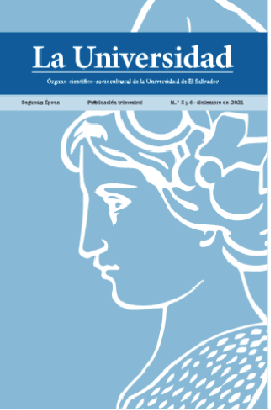Un camino largo y difícil
el problema de la baja tasa de graduados de la Ingeniería Eléctrica de la Facultad de Ingeniería y Arquitectura de la Universidad de El Salvador
Palabras clave:
Cohorte, Estudiantes, Ingeniería Eléctrica, Tasa de graduado, Tiempo para completar plan de estudio, Universidad de El SalvadorResumen
El tiempo y el porcentaje de estudiantes que finalizan un programa de estudios universitario han sido de especial interés para los académicos interesados en definir las claves del fracaso estudiantil en la educación superior. La cuantificación de ambas variables se obtiene a través del indicador tasa de graduado, calculado como el porcentaje de una cohorte que finalizó el programa en el tiempo establecido. Sobre todo, la tasa de graduado ofrece una idea general no del desempeño del estudiante sino de la institución y del compromiso que ésta tenga con su juventud. Tomando como caso de estudio 26 cohortes de la carrera de ingeniería eléctrica, de la Facultad de Ingeniería y Arquitectura de la Universidad de El Salvador que ingresaron al campus de San Salvador, enrolándose en un programa de 5.5 años, se determinó que ningún estudiante de las cohortes comprendidas en el período 1989-2007 se graduó en menos de 6 años. No fue sino hasta las cohortes 2008-2014 que se notó cierta mejora, obteniéndose un promedio de tasa de graduado para ese período del 2 %. Tomando en consideración una modificación al indicador, se amplió el tiempo de culminación a 150 %, se introdujo la tasa de graduado a 9 años. Se obtuvo que para las cohortes del período 1989-2007 la tasa de graduado a 9 años fue de 3.6 %, mientras que para el período 2008-2011 fue de 11.3%. De entre todas, fue la cohorte del año 2011 la que mostró mejores resultados, para 2019 se había graduado el 17.1 %. La disgregación por género determinó que en el caso de las mujeres la situación es más alarmante, de las 26 cohortes analizadas, únicamente 2 mujeres se graduaron en el plazo establecido en el plan de estudio. Evidentemente los resultados son desalentadores y esta investigación no pretende ser otra cosa que un análisis del grave y largamente ignorado problema de como conducir a más jóvenes a finalizar sus estudios universitarios en un tiempo razonable.
Descargas
Referencias
Asamblea Legislativa de El Salvador. (1995, 20 de diciembre). Ley de Educación Superior. Diario Oficial No. 236, Tomo 329.
La Investigación Científica UES (2014, 9 de junio). Escuela de Ingeniería Eléctrica UES: problemas y desafíos. YouTube. https://bit.ly/3yxdo5R
Martínez Cruz, Carlos Eugenio (2012) Escuela de Ingeniería Eléctrica: un largo
Martínez Cruz, Carlos Eugenio (2021) Revisión de las reformas curriculares de la carrera de Ingeniería Eléctrica. La Universidad, (1), 96-125.
Ministerio de Educación. (2003, 5 de marzo). Reglamento del Sistema de Unidades Valorativas y de Coeficientes de Unidades de Mérito. Diario Oficial No. 43, Tomo 358.
Ministerio de Educación. (2005, 24 de octubre). Reglamento General de Proceso de Ingreso de Aspirantes a Estudiar en la Universidad de El Salvador, Diario Oficial No. 197, Tomo 369
Descargas
Publicado
Número
Sección
Licencia
Derechos de autor 2022 Los autores que publican en la Revista La Universidad acuerdan los siguientes términos: Los autores continúan como propietarios de sus trabajos, cediendo de manera no exclusiva los derechos de difusión a la Revista La Universidad bajo los estándares de la Licencia Atribución-No comercial-Compartir igual: CC BY-NC-SA 4.0 Esta licencia permite usar una obra para crear otra obra o contenido, modificando o no la obra original, siempre que se cite al autor, la obra resultante se comparta bajo el mismo tipo de licencia y no tenga fines comerciales (https://creativecommons.org/licenses/by-nc-sa/4.0/deed.es)

Esta obra está bajo una licencia internacional Creative Commons Atribución-NoComercial-CompartirIgual 4.0.





